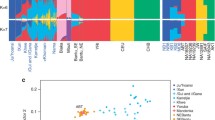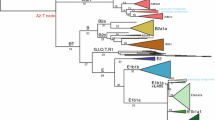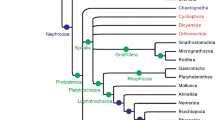Abstract
Using Kimura's distance measure we have calculated the average age of all major Alu subfamilies based on the most recent available data. We conclude that AluJ sequences are some 26 Myr older than previously thought. Furthermore, the origin of the FLA (Free Left Arm) Alu family can be traced back to the very beginning of the mammalian radiation.
One new minor subfamily is reported and discussed in the context of sequence diversity in major Alu subfamilies.
Similar content being viewed by others
References
Batzer MA, Kilroy GE, Richard PE, Shaikh TH, Desselle TD, Hoppens CL, Deininger PL (1990) Structure and variability of recently inserted Alu family members. Nucleic Acids Res 18:6793–6798
Batzer MA, Deininger PL, Hellmann-Blumberg U, Jurka J, Labuda D, Rubin CM, Schmid CW, Zietkiewicz E, Zuckerkandl E(1995) Standardized nomenclature for Alu repeats. J Mol Evol (in press)
Britten RJ (1986) Rates of DNA sequence evolution differ between taxonomic groups. Science 231:1393–1398
Britten RJ, Baron WF, Stout DB, Davidson EH (1988) Sources and evolution of human Alu repeated sequences. Proc Natl Acad Sci USA 85:4770–4774
Britten RJ (1994a) Evolutionary selection against change in many Alu repeat sequences interspersed through primate genomes. Proc Natl Acad Sci USA 91:5992–5996
Britten RJ (1994b) Evidence that most human Alu sequences were inserted in a process that ceased about 30 million years ago. Proc Natl Acad Sci USA 91:6148–6150
Casalotti SO, Pelaia G, Yakovlev AG, et al. (1992) Structure of the rat gene encoding the mitochondrial benzodiazepine receptor. Gene 121:377–382
Daniels GR, Deininger PL (1985) Repeat sequence families derived from mammalian tRNA genes. Nature 317:819–822
Deininger PL, Batzer MA (1993) Evolution of retroposons. In: Hecht MK (ed) Evolutionary biology, vol 27. Plenum Press, New York, pp 157–196
Deininger PL, Slagel VK (1988) Recently amplified Alu family members share a common parental Alu sequence. Mol Cell Biol 8:4566–4569
Faulkner DV, Jurka J (1988) Multiple aligned sequence editor (MASE). Trends Biochem Sci 13:321–322
Goodman M, Tagle DA, Fitch DHA, Bailey W, Czelusniak J, Koop BF, Benson P, Slightom JL (1990) Primate evolution at the DNA level and a classification of Hominoids. J Mol Evol 30:260–266
Hutchinson GB, Andrew SE, McDonald H, Goldberg YP, Graham R, Rommens JR, Hayden MR (1993) An Alu element retroposition in two families with Huntington disease defines a new active Alu subfamily. Nucleic Acids Res 21:3379–3383
Jurka J (1993) A new subfamily of recently retroposed human Alu repeats. Nucleic Acids Res 21:2252
Jurka J (1994) Repbase. NCBI Data Repository
Jurka J (1995) Origin and evolution of Alu repetitive elements. In: Maraia RJ (ed) Impact of short interspersed elements (SINEs) on the host genome. Landes Company, Austin, TX, pp 25–41
Jurka J, Milosavljevic A (1991) Reconstruction and analysis of human Alu genes. J Mol Evol 32:105–121
Jurka J, Smith T (1988) A fundamental division in the Alu family of repeated sequences. Proc Natl Acad Sci USA 85:4775–4778
Jurka J, Zuckerkandl E (1991) Free left arms as precursor molecules in the evolution of Alu sequences. J Mol Evol 33:49–56
Jurka J, Kaplan DJ, Duncan CH, Walichiewicz J, Milosavljevic A, Murali G, Solus IF (1993) Identification and characterization of new human medium reiteration frequency repeats. Nucleic Acids Res 21:1273–1279
Kimura M (1981) Estimation of evolutionary distances between homologous nucleotide sequences. Proc Natl Acad Sci USA 78:454–458
Labuda D, Striker G (1989) Sequence conservation in Alu evolution. Nucleic Acids Res 17:2477–2491
Li W-H, Gouy M, Sharp PM, O'hUigin C, Yang Y-W (1990) Molecular phylogeny of Rodentia, Lagomorpha, Primates, Artiodactyla and Carnivora and molecular clocks. Proc Natl Acad Sci USA 87:6703–6707
Martingetti JA, Brosius J (1993) BC200 RNA: a neural RNA polymerase III product encoded by a monomeric Alu element. Proc Natl Acad Sci USA 90:11563–11567
Matera AG, Hellmann U, Hintz MIT, Schmid CW (1990) Recently transposed Alu repeats result from multiple source genes. Nucleic Acids Res 18:6019–6023
Novacek MJ (1992) Mammalian phylogeny: shaking the tree. Nature 356:121–125
Ohta T (1995) Synonymous and nonsynonymous substitutions in mammalian genes and the nearly neutral theory. J Mol Evol 40:56–63
Quentin Y (1988) The Alu family developed through successive waves of fixation closely connected with primate lineage history. J Mol Evol 27:194–202
Quentin Y (1992) Origin of the Alu family: Alu like monomers gave birth to the left and the right arms of the Alu elements. Nucleic Acids Res 20:3397–3401
Quentin Y (1994) A master sequence related to a free left Alu monomer (FLAM) at the origin of the B 1 family in rodent genomes. Nucleic Acids Res 22:2222–2227
Saitou N, Ueda S (1994) Evolutionary rates of insertion and deletion in noncoding nucleotide sequences of primates. Mol Biol Evol 11: 504–512
Schmid CW, Shen CKJ (1985) The evolution of interspersed repetitive DNA sequences in mammals and other vertebrates. In: MacIntyre RJ (ed) Molecular evolutionary genetics. Plenum Press, New York, pp 323–358
Shen MR, Batzer MA, Deininger PL (1991) Evolution of the master Alu gene(s). J Mol Evol 33:311–320
Slagel V, Flemington E, Traina-Dorge V, Bradshaw H, Deininger P (1987) Clustering and subfamily relationships of the Alu family in the human genome. Mol Biol Evol 4:19–29
Ullu E, Tschudi C (1984) Alu sequences are processed 7SL RNA genes. Nature 312:171–172
Weiner AM, Deininger PL, Efstradiatis A (1986) Nonviral retroposons: genes, pseudogenes, and transposable elements generated by the reverse flow of genetic information. Annu Rev Biochem 55:631–661
Willard C, Nguyen HT, Schmid CW (1987) Existence of at least three distinct Alu subfamilies. J Mol Evol 26:180–186
Author information
Authors and Affiliations
Additional information
Correspondence to: J. Jurka
Rights and permissions
About this article
Cite this article
Kapitonov, V., Jurkal, J. The age of Alu subfamilies. J Mol Evol 42, 59–65 (1996). https://doi.org/10.1007/BF00163212
Received:
Accepted:
Issue Date:
DOI: https://doi.org/10.1007/BF00163212




